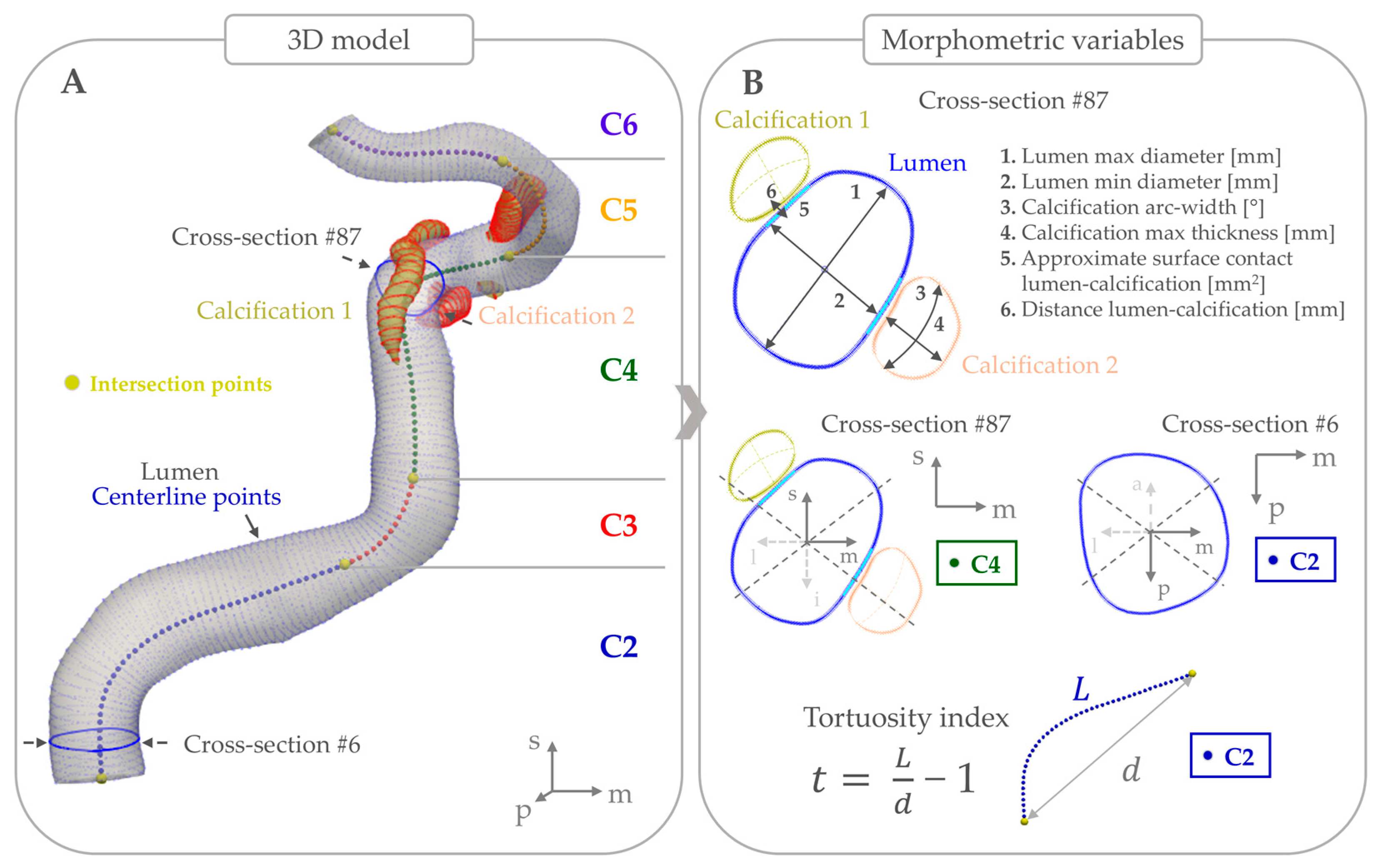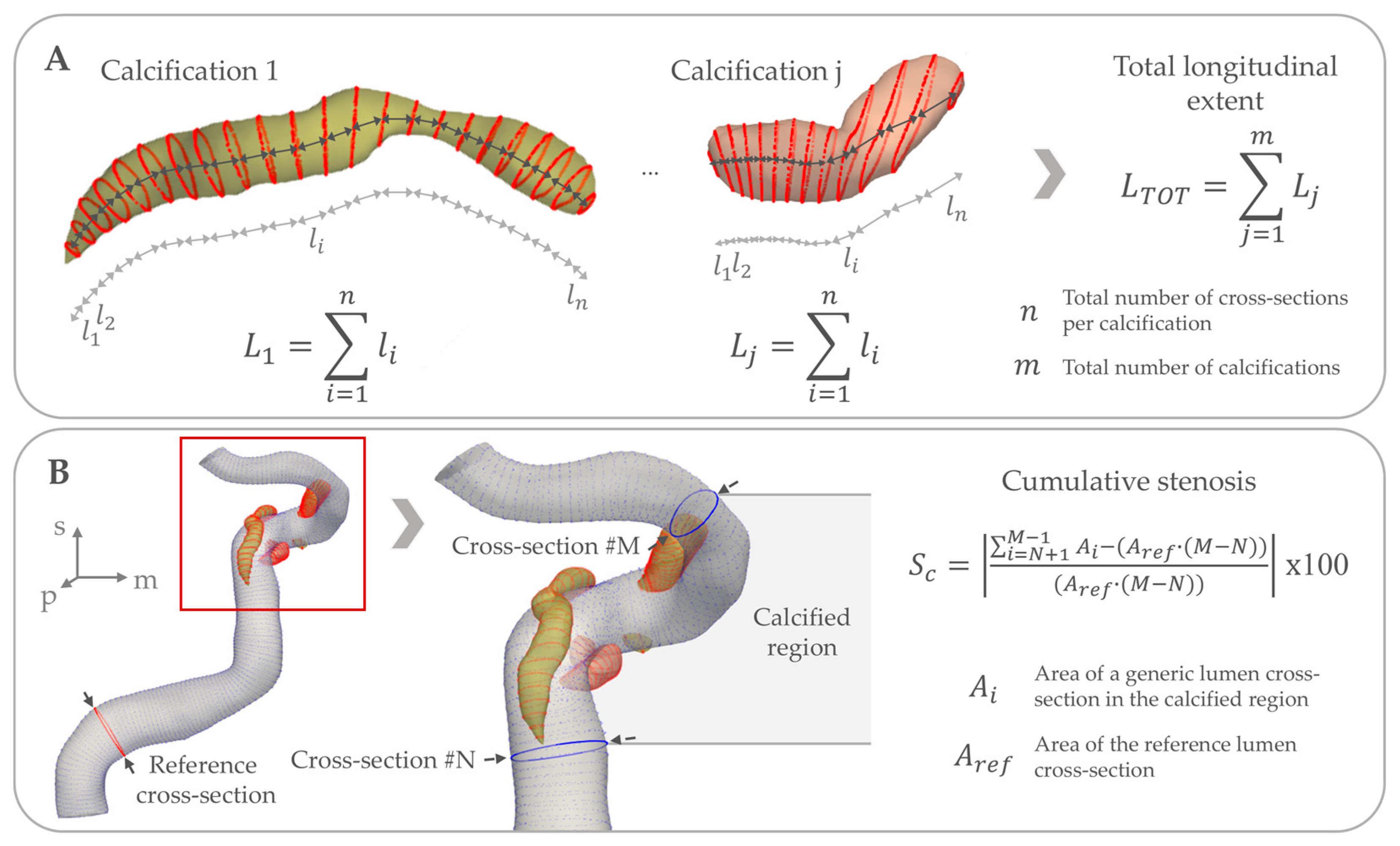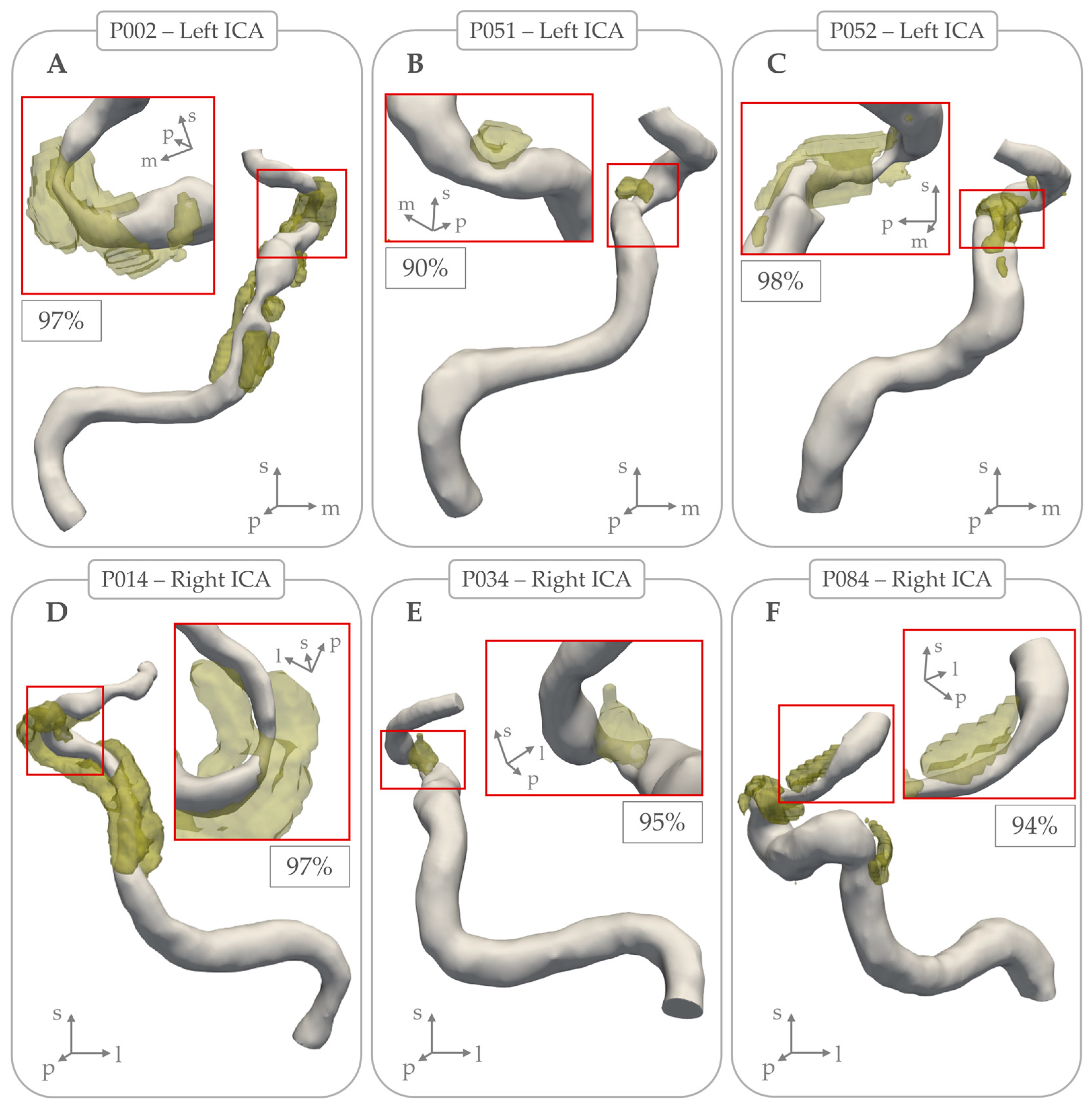Morphometry of Intracranial Carotid Artery Calcifications in Patients with Recent Cerebral Ischemia
Abstract
:1. Introduction
2. Materials and Methods
2.1. Study Setting
2.2. Image Acquisition
2.3. Image Segmentation Procedure
2.4. Assessment of Luminal and Calcification Measurements
2.5. Patient Characteristics
2.6. Statistical Analyses
3. Results
3.1. Study Characteristics
3.2. Morphometry and Comparisons Between Sides Ipsi- and Contralateral to the Cerebral Ischemia
3.3. Inter-Rater Agreement
4. Discussion
Strengths and Limitations
5. Conclusions
Author Contributions
Funding
Institutional Review Board Statement
Informed Consent Statement
Data Availability Statement
Conflicts of Interest
Abbreviations
| CT | Computed Tomography |
| TIA | Transient Ischemic Attack |
| IAC | Intracranial Artery Calcification |
| ICA | Intracranial Carotid Artery |
| SD | Standard Deviation |
| IQR | Inter Quartile Range |
| PARISK | Plaque At RISK |
| ESS | Erasmus Stroke Study |
| MDCTA | Multi-Detector Computed Tomography Angiography |
| HU | Hounsfield Unit |
| ICC | Intraclass Correlation Coefficient |
| CI | Confidence Interval |
References
- van den Beukel, T.C.; Wolters, F.J.; Siebert, U.; Spiering, W.; Ikram, M.A.; Vernooij, M.W.; de Jong, P.A.; Bos, D. Intracranial arteriosclerosis and the risk of dementia: A population-based cohort study. Alzheimer’s Dement. 2024, 20, 869–879. [Google Scholar] [CrossRef] [PubMed]
- Bos, D.; Portegies, M.L.; van der Lugt, A.; Bos, M.J.; Koudstaal, P.J.; Hofman, A.; Krestin, G.P.; Franco, O.H.; Vernooij, M.W.; Ikram, M.A. Intracranial carotid artery atherosclerosis and the risk of stroke in whites: The Rotterdam Study. JAMA Neurol. 2014, 71, 405–411. [Google Scholar] [CrossRef] [PubMed]
- Van den Beukel, T.C.; Van der Toorn, J.E.; Vernooij, M.W.; Kavousi, M.; Akyildiz, A.C.; De Jong, P.A.; Van der Lugt, A.; Ikram, M.K.; Bos, D. Morphological Subtypes of Intracranial Internal Carotid Artery Arteriosclerosis and the Risk of Stroke. Stroke 2022, 53, 1339–1347. [Google Scholar] [CrossRef] [PubMed]
- Bartstra, J.W.; van den Beukel, T.C.; Van Hecke, W.; Mali, W.; Spiering, W.; Koek, H.L.; Hendrikse, J.; de Jong, P.A.; den Harder, A.M. Intracranial Arterial Calcification: Prevalence, Risk Factors, and Consequences: JACC Review Topic of the Week. J. Am. Coll. Cardiol. 2020, 76, 1595–1604. [Google Scholar] [CrossRef]
- Gurel, K.; Khasiyev, F.; Spagnolo-Allende, A.; Rahman, S.; Liu, M.; Kulick, E.R.; Boehme, A.; Rundek, T.; Sv Elkind, M.; Marshall, R.S.; et al. The role of intracranial artery calcification (IAC) in stroke subtype and risk of vascular events. J. Stroke Cerebrovasc. Dis. 2023, 32, 107185. [Google Scholar] [CrossRef]
- Berghout, B.P.; Camarasa, R.Y.; Van Dam-Nolen, D.H.; van der Lugt, A.; de Bruijne, M.; Koudstaal, P.J.; Ikram, M.K.; Bos, D. Burden of intracranial artery calcification in white patients with ischemic stroke. Eur. Stroke J. 2024, 9, 743–750. [Google Scholar] [CrossRef]
- Foldyna, B.; Eslami, P.; Scholtz, J.E.; Baltrusaitis, K.; Lu, M.T.; Massaro, J.M.; D’Agostino, R.B., Sr.; Ferencik, M.; Aerts, H.; O’Donnell, C.J.; et al. Density and morphology of coronary artery calcium for the prediction of cardiovascular events: Insights from the Framingham Heart Study. Eur. Radiol. 2019, 29, 6140–6148. [Google Scholar] [CrossRef]
- Barrett, H.E.; Van der Heiden, K.; Farrell, E.; Gijsen, F.J.H.; Akyildiz, A.C. Calcifications in atherosclerotic plaques and impact on plaque biomechanics. J. Biomech. 2019, 87, 1–12. [Google Scholar] [CrossRef]
- Truijman, M.T.; Kooi, M.E.; van Dijk, A.C.; de Rotte, A.A.; van der Kolk, A.G.; Liem, M.I.; Schreuder, F.H.; Boersma, E.; Mess, W.H.; van Oostenbrugge, R.J.; et al. Plaque At RISK (PARISK): Prospective multicenter study to improve diagnosis of high-risk carotid plaques. Int. J. Stroke 2014, 9, 747–754. [Google Scholar] [CrossRef]
- Lev, M.H.; Gonzalez, R.G. CT Angiography and CT Perfusion Imaging. In Brain Mapping: The Methods, 2nd ed.; Toga, A.W., Mazziotta, J.C., Eds.; Elsevier Science: Amsterdam, The Netherlands, 2002; pp. 427–484. [Google Scholar]
- Bouthillier, A.; van Loveren, H.R.; Keller, J.T. Segments of the internal carotid artery: A new classification. Neurosurgery 1996, 38, 425–432; discussion 423–432. [Google Scholar] [CrossRef]
- Bogunovic, H.; Pozo, J.M.; Cardenes, R.; Villa-Uriol, M.C.; Blanc, R.; Piotin, M.; Frangi, A.F. Automated landmarking and geometric characterization of the carotid siphon. Med. Image Anal. 2012, 16, 889–903. [Google Scholar] [CrossRef] [PubMed]
- Woodcock, R.J., Jr.; Goldstein, J.H.; Kallmes, D.F.; Cloft, H.J.; Phillips, C.D. Angiographic correlation of CT calcification in the carotid siphon. AJNR Am. J. Neuroradiol. 1999, 20, 495–499. [Google Scholar] [PubMed]
- Babiarz, L.S.; Yousem, D.M.; Wasserman, B.A.; Wu, C.; Bilker, W.; Beauchamp, N.J., Jr. Cavernous carotid artery calcification and white matter ischemia. AJNR Am. J. Neuroradiol. 2003, 24, 872–877. [Google Scholar]
- Kockelkoren, R.; Vos, A.; Van Hecke, W.; Vink, A.; Bleys, R.L.; Verdoorn, D.; Mali, W.P.; Hendrikse, J.; Koek, H.L.; de Jong, P.A.; et al. Computed Tomographic Distinction of Intimal and Medial Calcification in the Intracranial Internal Carotid Artery. PLoS ONE 2017, 12, e0168360. [Google Scholar] [CrossRef]
- Luijten, S.P.R.; van der Donk, S.C.; Compagne, K.C.J.; Yo, L.S.F.; Sprengers, M.E.S.; Majoie, C.; Roos, Y.; van Zwam, W.H.; van Oostenbrugge, R.; Dippel, D.W.J.; et al. Intracranial carotid artery calcification subtype and collaterals in patients undergoing endovascular thrombectomy. Atherosclerosis 2021, 337, 1–6. [Google Scholar] [CrossRef]
- Mazzacane, F.; Del Bello, B.; Ferrari, F.; Persico, A.; Rognone, E.; Pichiecchio, A.; Padovani, A.; Cavallini, A.; Morotti, A.; Arba, F. Intracranial carotid artery calcification morphology differs in patients with lacunar and nonlacunar acute ischemic strokes. Eur. J. Neurol. 2023, 30, 963–969. [Google Scholar] [CrossRef] [PubMed]
- Compagne, K.C.J.; Clephas, P.R.D.; Majoie, C.; Roos, Y.; Berkhemer, O.A.; van Oostenbrugge, R.J.; van Zwam, W.H.; van Es, A.; Dippel, D.W.J.; van der Lugt, A.; et al. Intracranial Carotid Artery Calcification and Effect of Endovascular Stroke Treatment. Stroke 2018, 49, 2961–2968. [Google Scholar] [CrossRef]
- Phan, A.Q.; Yoo, B.; Liebeskind, D.S.; Sharma, L.K.; Bahr-Hosseini, M.; Alfonso, R.; Jahan, R.; Duckwiler, G.R.; Tateshima, S.; Nour, M.; et al. Intracranial artery calcification: Frequency, determinants, and modification of outcomes from endovascular thrombectomy. J. Stroke Cerebrovasc. Dis. 2024, 33, 107898. [Google Scholar] [CrossRef]
- Chimowitz, M.I.; Caplan, L.R. Is calcification of intracranial arteries important and how? JAMA Neurol. 2014, 71, 401–402. [Google Scholar] [CrossRef]
- Odink, A.E.; van der Lugt, A.; Hofman, A.; Hunink, M.G.; Breteler, M.M.; Krestin, G.P.; Witteman, J.C. Risk factors for coronary, aortic arch and carotid calcification; The Rotterdam Study. J. Hum. Hypertens. 2010, 24, 86–92. [Google Scholar] [CrossRef]
- van der Toorn, J.E.; Rueda-Ochoa, O.L.; van der Schaft, N.; Vernooij, M.W.; Ikram, M.A.; Bos, D.; Kavousi, M. Arterial calcification at multiple sites: Sex-specific cardiovascular risk profiles and mortality risk-the Rotterdam Study. BMC Med. 2020, 18, 263. [Google Scholar] [CrossRef]
- Bos, D.; Ikram, M.A.; Elias-Smale, S.E.; Krestin, G.P.; Hofman, A.; Witteman, J.C.; van der Lugt, A.; Vernooij, M.W. Calcification in major vessel beds relates to vascular brain disease. Arterioscler. Thromb. Vasc. Biol. 2011, 31, 2331–2337. [Google Scholar] [CrossRef]
- Lacolley, P.; Regnault, V.; Segers, P.; Laurent, S. Vascular Smooth Muscle Cells and Arterial Stiffening: Relevance in Development, Aging, and Disease. Physiol. Rev. 2017, 97, 1555–1617. [Google Scholar] [CrossRef] [PubMed]
- Fisher, C.M.; Gore, I.; Okabe, N.; White, P.D. Calcification of the Carotid Siphon. Circulation 1965, 32, 538–548. [Google Scholar] [CrossRef] [PubMed]
- Kataoka, Y.; Wolski, K.; Uno, K.; Puri, R.; Tuzcu, E.M.; Nissen, S.E.; Nicholls, S.J. Spotty calcification as a marker of accelerated progression of coronary atherosclerosis: Insights from serial intravascular ultrasound. J. Am. Coll. Cardiol. 2012, 59, 1592–1597. [Google Scholar] [CrossRef] [PubMed]
- Cardoso, L.; Kelly-Arnold, A.; Maldonado, N.; Laudier, D.; Weinbaum, S. Effect of tissue properties, shape and orientation of microcalcifications on vulnerable cap stability using different hyperelastic constitutive models. J. Biomech. 2014, 47, 870–877. [Google Scholar] [CrossRef]
- Power, A.; Chan, K.; Haydar, A.; Hamady, M.; Cairns, T.; Taube, D.; Duncan, N. Intracranial arterial calcification is highly prevalent in hemodialysis patients but does not associate with acute ischemic stroke. Hemodial. Int. 2011, 15, 256–263. [Google Scholar] [CrossRef]
- Baz, R.A.; Scheau, C.; Niscoveanu, C.; Bordei, P. Morphometry of the Entire Internal Carotid Artery on CT Angiography. Medicina 2021, 57, 832. [Google Scholar] [CrossRef]



| Characteristic | N/Mean (%/SD) | p-Value 1 | |
|---|---|---|---|
| Study | |||
| ESS | PARISK | ||
| N | 50 (50.0) | 50 (50.0) | - |
| Age, years | 71.0 (10.2) | 68.3 (7.1) | 0.13 |
| Sex, female | 24 (48.0) | 11 (22.0) | 0.01 |
| Ethnicity, Caucasian | 45 (90.0) | 48 (96.0) | 0.43 |
| Smoking behavior | |||
| Never | 9 (19.1) | 8 (16.0) | 0.30 |
| Former | 21 (44.7) | 30 (60.0) | |
| Current | 17 (36.2) | 12 (24.0) | |
| Hypertension | 36 (72.0) | 35 (83.3) | 0.30 |
| Diabetes Mellitus, type II | 20 (40.0) | 8 (17.8) | 0.03 |
| Dyslipidemia | 45 (90.0) | 41 (83.7) | 0.53 |
| History of cardiovascular disease | 32 (64.0) | 28 (57.1) | 0.62 |
| History of ischemic cardiovascular disease | 25 (50.0) | 26 (52.0) | 1.00 |
| Use of any anti-thrombotic medication | 38 (76.0) | 25 (50.0) | 0.01 |
| TOAST | <0.001 | ||
| Large artery atherosclerosis | 20 (40.0) | 2 (4.0) | |
| Small vessel occlusion | 8 (16.0) | 0 (0.0) | |
| Undetermined etiology | 22 (44.0) | 48 (96.0) | |
| Measurement | Total | Ipsilateral | Contralateral |
|---|---|---|---|
| Count, N | 200 | 100 | 100 |
| Maximum lumen diameter, mm | 5.9 [5.4, 6.4] | 5.8 [5.4, 6.4] | 5.9 [5.3, 6.4] |
| Mean lumen diameter, mm | 4.0 [3.7, 4.4] | 4.0 [3.7, 4.4] | 4.0 [3.8, 4.4] |
| Minimum lumen diameter, mm | 2.2 [1.9, 2.5] | 2.3 [1.9, 2.5] | 2.2 [1.8, 2.5] |
| Total measured artery length, mm | 75.4 [70.7, 80.8] | 75.4 [71.5, 79.6] | 75.5 [69.8, 81.1] |
| Arterial tortuosity index | 0.7 [0.6, 0.8] | 0.7 [0.6, 0.8] | 0.7 [0.6, 0.9] |
| Non-petrous arterial tortuosity index | 0.8 [0.7, 1.0] | 0.8 [0.6, 0.9] | 0.8 [0.7, 1.0] |
| Total longitudinal extent of calcifications, mm | 16.2 [7.6, 26.3] | 16.2 [8.1, 25.4] | 16.1 [6.8, 27.0] |
| Calcification count, n | 4.0 [2.0, 6.0] | 4.0 [2.0, 6.0] | 4.0 [2.0, 6.0] |
| Total surface contact of lumen with calcification, mm2 | 12.8 [3.0, 26.3] | 11.9 [3.1, 26.5] | 13.8 [2.8, 26.0] |
| Mean distance from calcification to lumen boundary, mm | 0.3 [0.2, 0.4] | 0.3 [0.2, 0.4] | 0.3 [0.2, 0.4] |
| Maximum calcification area, mm2 | 3.9 [2.7, 6.6] | 3.9 [2.7, 7.2] | 3.9 [2.7, 6.3] |
| Mean calcification area, mm2 | 1.8 [1.2, 2.7] | 1.7 [1.2, 2.8] | 1.9 [1.3, 2.7] |
| Maximum calcification arc width, ° | 80.0 [58.0, 117.3] | 81.0 [53.0, 121.5] | 77.0 [62.5, 115.5] |
| Mean calcification arc width, ° | 43.5 [32.3, 53.2] | 41.2 [32.1, 52.9] | 45.4 [33.9, 53.4] |
| Maximum calcification thickness, mm | 1.9 [1.5, 2.4] | 1.9 [1.6, 2.3] | 1.9 [1.5, 2.4] |
| Mean calcification thickness, mm | 1.2 [1.0, 1.4] | 1.2 [1.0, 1.4] | 1.2 [0.9, 1.4] |
| Maximum calcification area, mm2 | 3.9 [2.7, 6.6] | 3.9 [2.7, 7.2] | 3.9 [2.7, 6.3] |
| Maximum cumulative stenosis from calcification, % | 55.5 [39.1, 66.6] | 55.4 [39.3, 67.9] | 56.5 [39.0, 65.3] |
| Highest stenosis severity due to calcification, N | |||
| 30–50% | 42 (21.0) | 20 (20.0) | 22 (22.0) |
| 50–70% | 61 (30.5) | 32 (32.0) | 29 (29.0) |
| 70–90% | 75 (37.5) | 39 (39.0) | 36 (36.0) |
| >90% | 9 (4.5) | 3 (3.0) | 6 (6.0) |
| Predominant location of calcifications, per anatomical section | |||
| C2 | 5 (2.5) | 4 (4.0) | 1 (1.0) |
| C3 | 5 (2.5) | 2 (2.0) | 3 (3.0) |
| C4 | 112 (56.0) | 56 (56.0) | 56 (56.0) |
| C5 | 47 (23.5) | 22 (22.0) | 25 (25.0) |
| C6 | 31 (15.5) | 16 (16.0) | 15 (15.0) |
| Predominant orientation of calcifications to the sagittal plane | |||
| Medial | 17 (8.5) | 6 (6.0) | 11 (11.0) |
| Lateral | 49 (24.5) | 26 (26.0) | 23 (23.0) |
| Anteroinferior | 57 (28.5) | 32 (32.0) | 25 (25.0) |
| Posterosuperior | 77 (38.5) | 36 (36.0) | 41 (41.0) |
| Measurement | ICC 1 | 95% Confidence Interval |
|---|---|---|
| Maximum lumen diameter | 0.27 | −0.02|0.65 |
| Mean lumen diameter | 0.59 | 0.15|0.86 |
| Minimum lumen diameter | 0.57 | 0.21|0.85 |
| Total measured artery length | 0.78 | 0.29|0.94 |
| Arterial tortuosity index | 0.87 | 0.60|0.96 |
| Non-petrous arterial tortuosity index | 0.90 | 0.74|0.97 |
| Total longitudinal extent of calcifications | 0.99 | 0.99|1.00 |
| Calcification count | 0.90 | 0.74|0.97 |
| Total surface contact of lumen with calcification | 0.71 | 0.37|0.91 |
| Mean distance from calcification to lumen boundary | 0.25 | −0.10|0.68 |
| Maximum calcification area | 0.99 | 0.97|1.00 |
| Mean calcification area | 1.00 | 0.99|1.00 |
| Maximum calcification arcwidth | 0.98 | 0.94|0.99 |
| Mean calcification arcwidth | 0.99 | 0.96|1.00 |
| Maximum calcification thickness | 0.90 | 0.74|0.97 |
| Mean calcification thickness | 0.97 | 0.92|0.99 |
Disclaimer/Publisher’s Note: The statements, opinions and data contained in all publications are solely those of the individual author(s) and contributor(s) and not of MDPI and/or the editor(s). MDPI and/or the editor(s) disclaim responsibility for any injury to people or property resulting from any ideas, methods, instructions or products referred to in the content. |
© 2025 by the authors. Licensee MDPI, Basel, Switzerland. This article is an open access article distributed under the terms and conditions of the Creative Commons Attribution (CC BY) license (https://creativecommons.org/licenses/by/4.0/).
Share and Cite
Berghout, B.P.; Fontana, F.; Huijben, F.; Korteland, S.-A.; Kooi, M.E.; Nederkoorn, P.J.; de Jong, P.A.; Gijsen, F.J.; Pirola, S.; Ikram, M.K.; et al. Morphometry of Intracranial Carotid Artery Calcifications in Patients with Recent Cerebral Ischemia. J. Clin. Med. 2025, 14, 3274. https://doi.org/10.3390/jcm14103274
Berghout BP, Fontana F, Huijben F, Korteland S-A, Kooi ME, Nederkoorn PJ, de Jong PA, Gijsen FJ, Pirola S, Ikram MK, et al. Morphometry of Intracranial Carotid Artery Calcifications in Patients with Recent Cerebral Ischemia. Journal of Clinical Medicine. 2025; 14(10):3274. https://doi.org/10.3390/jcm14103274
Chicago/Turabian StyleBerghout, Bernhard P., Federica Fontana, Fennika Huijben, Suze-Anne Korteland, M. Eline Kooi, Paul J. Nederkoorn, Pim A. de Jong, Frank J. Gijsen, Selene Pirola, M. Kamran Ikram, and et al. 2025. "Morphometry of Intracranial Carotid Artery Calcifications in Patients with Recent Cerebral Ischemia" Journal of Clinical Medicine 14, no. 10: 3274. https://doi.org/10.3390/jcm14103274
APA StyleBerghout, B. P., Fontana, F., Huijben, F., Korteland, S.-A., Kooi, M. E., Nederkoorn, P. J., de Jong, P. A., Gijsen, F. J., Pirola, S., Ikram, M. K., Bos, D., & Akyildiz, A. C. (2025). Morphometry of Intracranial Carotid Artery Calcifications in Patients with Recent Cerebral Ischemia. Journal of Clinical Medicine, 14(10), 3274. https://doi.org/10.3390/jcm14103274







